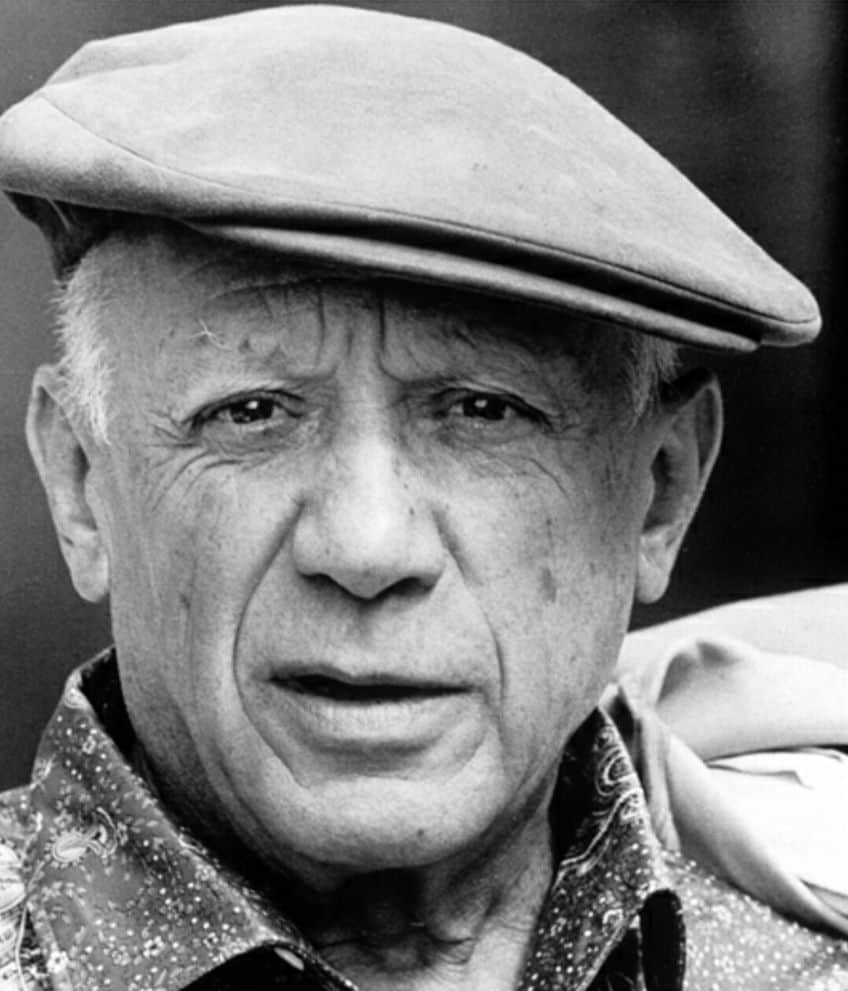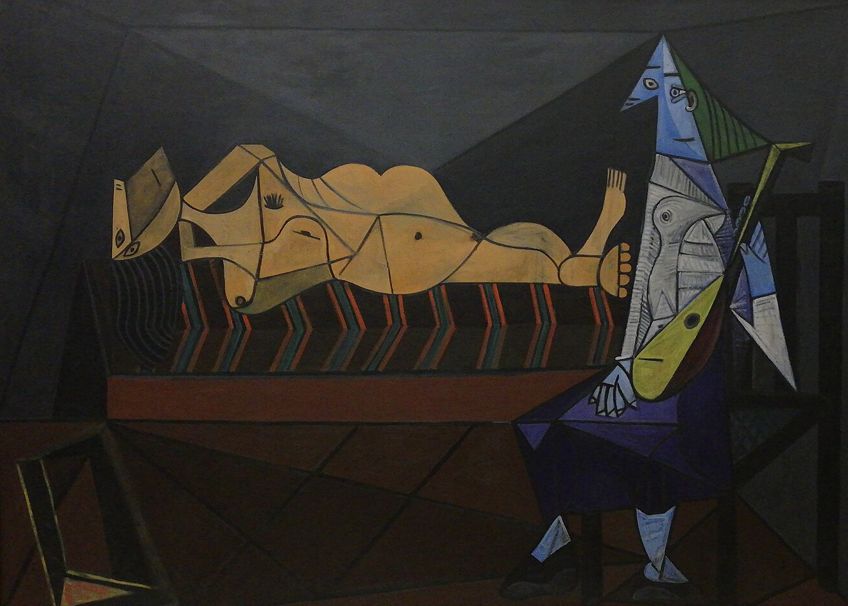“Le Rêve” by Pablo Picasso – A Detailed Painting Analysis
One of the most iconic and enigmatic works of art in the history of modern painting is undoubtedly Le Rêve (The Dream) by Pablo Picasso. A La Rêve painting analysis reveals the painting’s complex themes, such as eroticism, femininity, and the subconscious mind. As we explore the layers of meaning within this masterpiece, we can begin to understand why The Dream painting continues to inspire and intrigue art lovers around the world.
Artist Abstract: Who Was Pablo Picasso?
Pablo Picasso was a Spanish artist who is widely regarded as one of the most important and influential artists of the 20th century. Born in 1881 in Malaga, Spain, Picasso showed an early talent for drawing and painting and began studying art formally at a young age. He moved to Paris in 1900, where he quickly established himself as a leading figure in the city’s vibrant art scene. Picasso’s early works were characterized by their bright, bold colors and their exploration of various modernist styles, including fauvism and symbolism. He soon began to experiment with new techniques and forms, and in 1907 he co-founded the cubist movement along with Georges Braque (1882-1963).

Over the course of his long and prolific career, Picasso produced an enormous body of work, spanning a wide range of media and styles. He is perhaps best known for his cubist paintings, which broke down traditional forms and representations in favor of fractured, multi-dimensional compositions. However, he also worked in a variety of other styles, including neoclassicism, surrealism, and expressionism. Today, Picasso’s legacy continues to resonate throughout the art world and beyond. His works can be found in some of the world’s most prestigious museums, and his influence can be seen in the work of countless contemporary artists. His life and work continue to fascinate and inspire people around the globe, cementing his place as one of the greatest artists of all time.
The Dream by Picasso
| Date | 1932 |
| Medium | Oil on canvas |
| Dimensions (cm) | 130 x 97 |
| Style | Cubism |
| Type | Portraiture |
| Subject | Marie-Thérèse Walter |
| Location | Private collection of Steven A. Cohen |
The Dream painting has captivated audiences and critics alike since its creation in 1932, with its rich symbolism and bold, innovative style. The use of color, form, and composition in The Dream by Picasso demonstrates his mastery of the avant-garde style of surrealism, which challenged traditional notions of art and beauty.
Before we do a La Rêve painting analysis, we will place this work of art in the context of the larger socio-political moment in France and Spain (the two spaces Picasso was active in during the time of painting The Dream), and look at the painting within the context of Picasso’s career.
Le Rêve by Pablo Picasso in the French and Spanish Socio-Political Context
Le Rêve (The Dream) by Pablo Picasso was created in 1932, a time of great political and social upheaval in both France and Spain. France, the country was still recovering from the devastation of World War I and was now facing the looming threat of World War II. The French government was struggling to maintain order amidst rising unemployment, labor strikes, and a growing fascist movement. Meanwhile, in Spain, the country was embroiled in a bitter civil war between the leftist government and nationalist forces led by General Francisco Franco.
In this tumultuous climate, Picasso’s work took on new meanings and resonances. Le Rêve, with its sensuous, erotic imagery and bold use of color, was a radical departure from the more austere and cerebral works of the cubist period. It represented a return to the more expressive, emotive styles of his earlier work, and was seen as a provocative statement of the artist’s personal and political beliefs. At the same time, however, the painting was also deeply rooted in the traditions and cultural history of both France and Spain. The dream-like imagery and flowing, curvilinear forms of the painting reflected the influence of the French surrealist movement, while the bold, vibrant colors were reminiscent of the bold palette of traditional Spanish art.
Le Rêve by Pablo Picasso Within the Context of His Career
Le Rêve (The Dream) is one of the most legendary paintings by Pablo Picasso, created in 1932 during a period of transition in the artist’s career. Picasso had already established himself as a leading figure in the art world with his pioneering cubist works of the early 20th century. However, by the 1930s, he was looking to explore new avenues of artistic expression. Le Rêve represents a departure from the formal experimentation of his cubist period, with its sensuous, organic forms and vivid, expressive color palette. It is widely considered to be one of the most sensual and erotic works of Picasso’s career, depicting a reclining nude woman with a dreamlike quality that blurs the boundaries between the conscious and the subconscious.
At the same time, Le Rêve also shows the artist’s continuing interest in exploring new forms and techniques.
The painting is notable for its use of impasto, a technique in which paint is applied thickly to the canvas, creating a rich, textural effect. This technique would become increasingly important in Picasso’s later works, as he continued to push the boundaries of traditional painting techniques. Le Rêve also reveals Picasso’s ongoing fascination with the female form, which would become a central theme in much of his later work. The reclining nude figure in the painting can be seen as a continuation of the artist’s interest in the classical tradition of the female nude, while also subverting those conventions with its bold, expressionistic style.
Reception of The Dream Painting
Le Rêve (The Dream) by Pablo Picasso was first exhibited in 1932 at the Galerie Georges Petit in Paris. The painting was part of a larger exhibition of Picasso’s work, which included a range of styles and techniques from throughout his career. The public reception to Le Rêve was mixed, with some viewers praising its sensuality and bold use of color, while others were put off by its eroticism and unconventional style. Among the most vocal critics of the painting was the French writer and art critic André Breton (1896-1966), who was a leading figure in the surrealist movement at the time. Breton praised the painting’s “pure psychic automatism,” but also expressed reservations about its overt sexuality.

Another prominent critic who weighed in on Le Rêve was the American journalist and art critic Henry McBride (1867-1962). In a review for the New York Sun, McBride described the painting as “a marvel of modern art,” praising its “strikingly new” approach to form and color. He also singled out the painting’s sensuous and erotic qualities, writing that it “succeeds in embodying the subconscious wish of the lover for his mistress.”
Despite these mixed reviews, Le Rêve would go on to become one of Picasso’s most famous and enduring works. It has been the subject of numerous exhibitions and scholarly analyses and remains a potent symbol of the artist’s ongoing exploration of the human form and the subconscious mind.
La Rêve Painting Analysis
Le Rêve (The Dream) is a striking and titillating painting by Pablo Picasso. This oil on canvas work measures 130 x 97 cm and depicts a lounging nude woman in a highly abstracted and stylized form. Even though the woman in the picture only has one breast bared to the viewer, the feeling of the classic look is enticed by Picasso – the painter inviting you to observe the model as she relaxes passively under your gaze.
Let us look more closely at the technical elements of this artwork.
Composition
The composition is dominated by bold and vivid colors, with the woman’s body rendered in rich shades of pink, yellow, and blue. The painting also features a number of intricate and detailed patterns and textures, adding to its overall complexity and depth. Picasso applied the cubist composition approach, by superimposing multiple views of the same composition. This creates a distorted and refreshing layout of the typical nude.
Subject Matter
At its core, the subject matter of Le Rêve is the female form and its sensual, erotic potential. The woman depicted in the painting is shown reclining on a couch, her body contorted and twisted in a highly stylized manner. Her face is turned away from the viewer, adding to the enigmatic and dreamlike quality of the painting. The woman’s nudity and the highly eroticized nature of her pose suggest a deep and powerful connection between sexuality and the unconscious mind.
Color and Light
Color and light play a crucial role in the composition of Le Rêve. The woman’s body is rendered in a range of vivid and intense hues, with her skin appearing to glow with a warm and inviting light. The background of the painting is dominated by deep, rich blues and greens, adding to the dreamlike and otherworldly quality of the work. The use of color and light in Le Rêve is highly symbolic, suggesting a deep and complex relationship between the physical body and the emotional and psychological realms.
Texture
The texture of Le Rêve is highly detailed and intricate, with a range of patterns and textures adding to the overall visual impact of the work. The woman’s hair, for example, is rendered in a series of tightly coiled curls, while her skin is covered in a network of intricate lines and markings.
These details serve to further emphasize the complexity and richness of the painting, while also adding to its sensual and erotic qualities.
Perspective
In terms of perspective and form, Le Rêve is highly abstract and stylized. The woman’s body is rendered in a highly distorted and exaggerated manner, with her limbs and torso contorted and twisted in a way that suggests a deep and powerful emotional and psychological state. The use of abstraction and distortion is highly effective in conveying the dreamlike and otherworldly qualities of the painting, while also emphasizing the intense emotional and psychological connections between the female form and the unconscious mind.
Symbolism
Finally, the symbolism of Le Rêve is complex and multilayered. The painting is highly suggestive of a deep and powerful connection between the physical body and the unconscious mind, with the female form serving as a powerful conduit for exploring the mysteries of the human psyche. The highly stylized and abstracted form of the painting suggests a deep and powerful emotional and psychological intensity, while the vivid and intense colors and patterns serve to further emphasize the rich and complex nature of the work. Overall, Le Rêve is a masterful and highly innovative work of art, showcasing Picasso’s ongoing exploration of the human form and its deep and powerful connections to the inner workings of the human mind.

In conclusion, Le Rêve (The Dream) by Pablo Picasso remains a powerful work of art that continues to enlighten and challenge viewers to this day. Through its rich symbolism and innovative style, The Dream painting offers a glimpse into the depths of the human psyche and the complex interplay between conscious and unconscious thought. Picasso’s masterful use of color, form, and composition in The Dream established him as one of the most influential artists of the 20th century, and helped pave the way for the development of new artistic movements such as Abstract Expressionism and Pop Art. As we continue to study and appreciate this masterpiece, we are reminded of the enduring power of art to evoke emotion, spark imagination, and deepen our understanding of ourselves and the world around us.
Frequently Asked Questions
Why Was Picasso Such an Influential Artist?
Picasso’s influence on the art world of the 20th century cannot be overstated. His innovations in Cubism and his bold experimentation with new forms and techniques paved the way for countless artists who followed in his wake. His work also had a profound impact on popular culture, with his images appearing in everything from advertisements to political propaganda. Throughout his career, Picasso was known for his larger-than-life personality and his controversial personal life. He was a charismatic and often tempestuous figure, known for his numerous romantic entanglements and his tumultuous relationships with family and friends.
What Is the Political Relevance of Le Rêve by Pablo Picasso?
Overall, Le Rêve can be seen as a powerful statement of the artist’s personal and political beliefs, as well as a reflection of the broader cultural and historical forces that shaped his work. It remains a potent symbol of the artistic and social upheavals of the early 20th century, and continues to inspire and challenge viewers to this day.
How Was Le Rêve by Pablo Picasso Received When It Was First Exhibited?
Overall, the initial reception to Le Rêve reflects the complex and often contentious nature of Picasso’s work, as well as the broader cultural and social contexts in which it was created. While some critics were immediately drawn to the painting’s bold style and sensuous imagery, others were put off by its overt sexuality and unconventional approach to form and composition. Nonetheless, the painting remains an enduring testament to Picasso’s ongoing experimentation and innovation, and continues to inspire and captivate viewers to this day.
Nicolene Burger, a South African multimedia artist and creative consultant, specializes in oil painting and performance art. She earned her BA in Visual Arts from Stellenbosch University in 2017. Nicolene’s artistic journey includes exhibitions in South Korea, participation in the 2019 ICA Live Art Workshop, and solo exhibitions. She is currently pursuing a practice-based master’s degree in theater and performance. Nicolene focuses on fostering sustainable creative practices and offers coaching sessions for fellow artists, emphasizing the profound communicative power of art for healing and connection. Nicolene writes blog posts on art history for artfilemagazine with a focus on famous artists and contemporary art.
Learn more about Nicolene Burger and about us.
Cite this Article
Nicolene, Burger, ““Le Rêve” by Pablo Picasso – A Detailed Painting Analysis.” artfilemagazine – Your Online Art Source. August 23, 2023. URL: https://artfilemagazine.com/le-reve-by-pablo-picasso/
Burger, N. (2023, 23 August). “Le Rêve” by Pablo Picasso – A Detailed Painting Analysis. artfilemagazine – Your Online Art Source. https://artfilemagazine.com/le-reve-by-pablo-picasso/
Burger, Nicolene. ““Le Rêve” by Pablo Picasso – A Detailed Painting Analysis.” artfilemagazine – Your Online Art Source, August 23, 2023. https://artfilemagazine.com/le-reve-by-pablo-picasso/.


